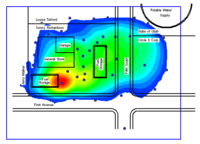GMS:Converting 2D Scatter Points to Other Types of Data
From XMS Wiki
(Redirected from GMS:Scatter Points to Observation Points)
Jump to navigationJump to search
2D scatter points may be converted to other types of data used in GMS, such as a TIN, 2D mesh nodes, or observation points. 2D scatter points are converted by using the following commands in the Scatter Points menu:
- Scatter Points → TIN
- Creates a set of TIN vertices. These vertices are automatically triangulated to form a TIN.
- Scatter Points → Mesh Nodes
- Creates a set of 2D finite element nodes from the points in the active scatter point set. Requires triangulating the nodes to create the 2D mesh.
- Scatter Points → Obs. Pts.
- Creates one observation point for each of the scatter points in the active scatter point set. The active dataset values become the measured values for the observation points. Create a coverage with a measurement before executing this command.
- Scatter Points → 3D Scatter Points
- Creates a 3D scatter point set from the 2D scatter points. All of the datasets are copied to the 3D scatter points. The Z (elevation) of the 3D scatter points is set to the Z of the 2D scatter points at the time of conversion.
Scatter points can also be converted to either a 2D grid or 3D grid by using the bounding grid commands.
- Bounding 2D Grid...
- Creates a 2D grid that bounds or contains all of the scatter points in the active set. Will launch the Create Finite Difference Grid dialog which allows defining the grid dimensions.
- Bounding 3D Grid...
- Creates a 3D grid that bounds or contains all of the scatter points in the active set. Will launch the Create Finite Difference Grid dialog which allows defining the grid dimensions.
| [hide]GMS – Groundwater Modeling System | ||
|---|---|---|
| Modules: | 2D Grid • 2D Mesh • 2D Scatter Point • 3D Grid • 3D Mesh • 3D Scatter Point • Boreholes • GIS • Map • Solid • TINs • UGrids | |
| Models: | FEFLOW • FEMWATER • HydroGeoSphere • MODAEM • MODFLOW • MODPATH • mod-PATH3DU • MT3DMS • MT3D-USGS • PEST • PHT3D • RT3D • SEAM3D • SEAWAT • SEEP2D • T-PROGS • ZONEBUDGET | |
| Aquaveo | ||
